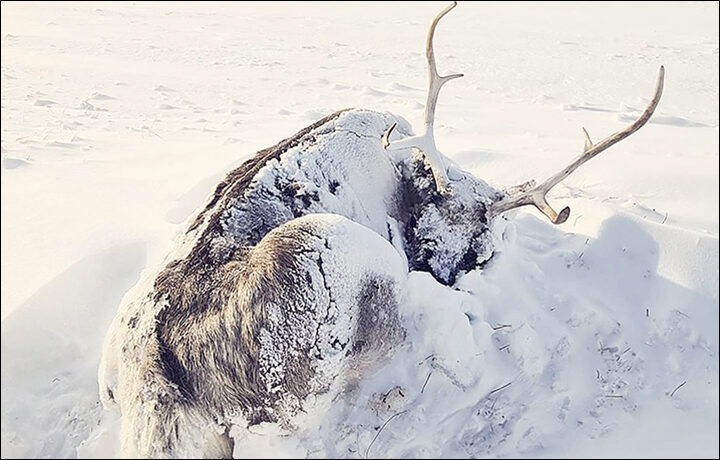
New ideas to rescue reindeer herding are urgently needed for the Yamal peninsula, said members of the scientific expedition that just returned from the trip to its northern tundra.
'The perished reindeer were observed all around the northern tundra, among them were wild reindeer who also suffered from icing and lack of forage. Herders showed us that their hooves were worn out because they had to dig through ice so much', said researchers Alexandra Terekhina and Alexander Volkovitsky from the Arctic Research Station in Labytnangi, part of the Institute of Plant and Animal Ecology.
First reports about winter rains followed by lengthy spells of extremely cold weather on Yamal appeared in December 2020.
Alarmed herders said the unusual weather caused formation of thick - up to three centimetres - ice cover over lichen.
For reindeer, this means an impossible task to reach forage as they graze winter pastures, which is why hooves were so badly worn out on the dead animals seen by the scientists.
Some of the Yamal peninsula's domestic animals left traditional winter pastures and followed wild reindeer hoping to survive.
By spring the number of animals that could have died from starvation was estimated in thousands.
'We are clearly speaking of thousands of animals, but there is no exact number of the perished reindeer yet, because the herders are still roaming the Seyakhinskaya tundra as they try to gather the herds together.
Overall there are around 65,000 reindeer in this northern part of the peninsula's tundra. Not all of them were on the iced territory', explained Alexandra Terekhina.
The last devastating loss of domestic and wild reindeer on the Yamal peninsula was in winter 2013-2014, when up to 90,000 animals starved to death in three districts of the Yamalo-Nenets Autonomous District.
The ecologists believe that changing climate may have caused the deadly mix of weather events like thin snow cover, followed by winter rains and then days of severe frosts.
'Our team made several trips to study snow profiles to the north of Sabetta and in the tundra between Labytnangi and Sabetta. We studied layers of ice covering soil and vegetation, and saw that all dark lichen hilltops and slopes with little snow were also covered with ice', said Alexander Volkovitsky.
While periodic glaciation is typical for the Yamal peninsula, scientists believe that the changing climate might be affecting its frequency, and causing it to happen more often.
Mass death of reindeer caused by the similar combination of rain followed by cold weather was recently reported thousands of miles south-east from Yamal on the Kamchatka Peninsula. At least 300 animals died at the northwests of the peninsula because they couldn't get to food through the layer of ice and snow.
Several other cases of mass reindeer deaths caused by icy rains were reported this year in Norway and Sweden, with local authorities sending tonnes of forage to affected Arctic areas, and drafting programs of government support to herders.
Similar support like free delivery of reindeer food and gasoline for snowmobiles has been provided to herders by Yamalsky district and Seyakha village administrations since last December.
'We've got to think of radically new solutions. By reindeer herders' terms, the Yamal peninsula is quite populated, and there aren't that many spare herding areas. Also, and possibly this might be the main issue, since Soviet times reindeer herders who populated the northern, Seyakhinskaya tundra, were limited to that area only, while in the past they were moving herds to forest areas for winters,' said Alexandra Terekhina.




Reader Comments
We know that the PTB miscalled their guess when they said that it was 'woebal glorming' / 'AGW'; so they had to backtrack and came up with the 'more inclusive' better said 'all inclusive' term of 'climate change.' (After all, 'change' is in the definition of climate.) Now, no matter whether it gets cold or hot it will be mankind's fault because he didn't wear a face diaper and had to kill granny. (or such.)
R.C.
I hear Bill Gates wants to hasten the grand solar minimum.
Have te a nice day y’all!